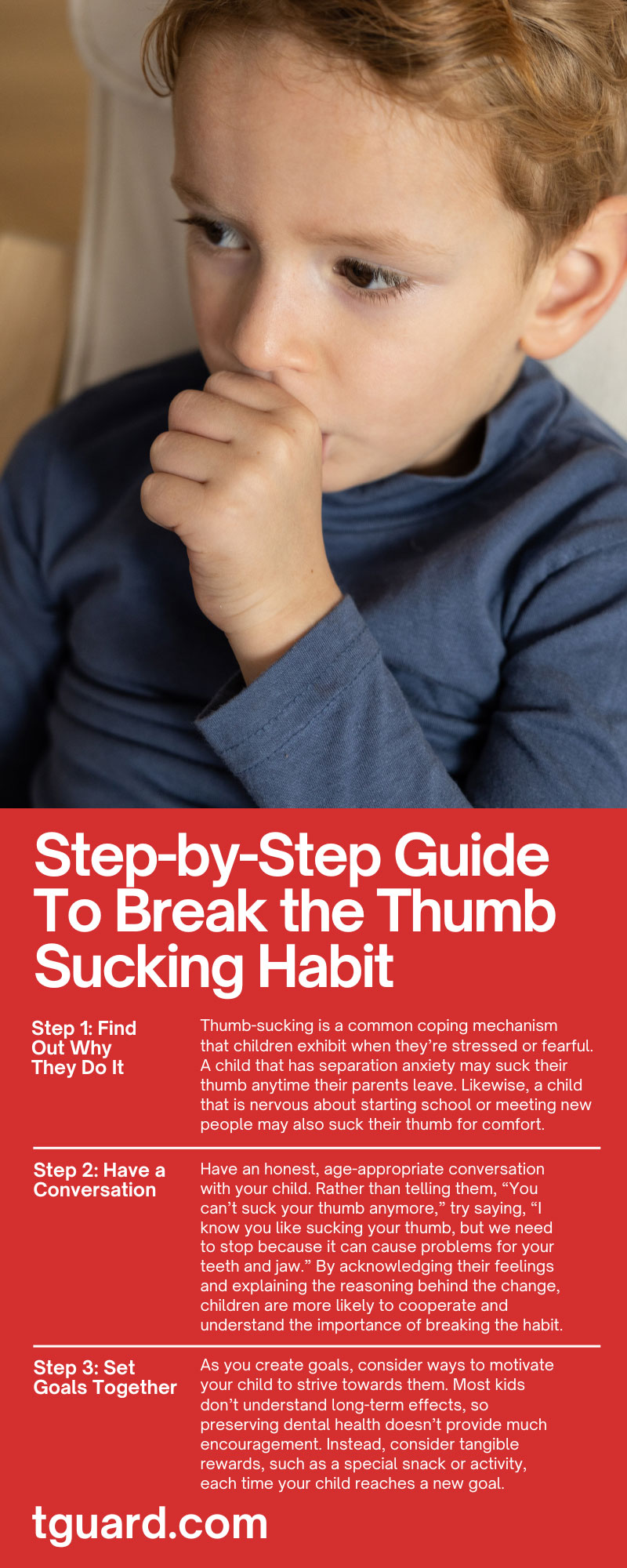Thumb-sucking is a habit that goes from adorable to addictive as toddlers become young children. The behavior that naturally soothed them during infancy can now alter the shape of their jaw and palate, potentially requiring medical intervention to correct. By helping your child quit thumb-sucking early on, you can prevent the negative consequences that may arise from it. The below step-by-step guide details how to break a thumb-sucking habit.
Step 1: Find Out Why They Do It
Thumb-sucking serves different purposes for children depending on the situation; you need to know why your child sucks their thumb to help them stop. This can take time, especially if you aren’t sure about what drives the habit. To ease things, here are some of the most common reasons for thumb-sucking:
Anxiety
Thumb-sucking is a common coping mechanism that children exhibit when they’re stressed or fearful. A child that has separation anxiety may suck their thumb anytime their parents leave. Likewise, a child that is nervous about starting school or meeting new people may also suck their thumb for comfort.
Parent Tip
If your child consistently struggles with anxiety, consider talking with their pediatrician about professional help. A counselor or therapist can work with your child to develop healthy coping mechanisms for their anxiety.
Boredom
Children can also resort to sucking their thumbs when they’re bored or looking for something to do. They may be lounging on the couch and watching cartoons with their hands free, giving them the perfect opportunity. Thumb and finger sucking releases endorphins in the brain, creating a sense of relaxation and pleasure.
Habit
In some cases, thumb-sucking transitions from a behavioral issue in infancy to a habitual one in toddlerhood. Your child enjoys the rhythm and comfort of thumb-sucking, which their mind and body have grown accustomed to. Not to mention, that natural chemical release can be highly addictive since it relaxes them.
Step 2: Have a Conversation
Knowing that thumb-sucking is an issue is only half of the battle, since you also have to “convince” your child they need to stop. You can’t go from letting your child suck their thumb whenever they want to stopping cold turkey, as this can confuse and frustrate them. Young children don’t understand the world the way we do, so they may see you as the “bad guy” if you suddenly take away their comfort mechanism.
Instead, have an honest, age-appropriate conversation with your child. Rather than telling them, “You can’t suck your thumb anymore,” try saying, “I know you like sucking your thumb, but we need to stop because it can cause problems for your teeth and jaw.” By acknowledging their feelings and explaining the reasoning behind the change, children are more likely to cooperate and understand the importance of breaking the habit.
When you have the conversation, choose a calm, quiet moment to discuss the habit, ensuring there are no distractions. Encourage your child to ask questions and express any concerns, so they know that they are part of the process.
Parent Tip
You can start the conversation by sitting together and reading a picture book about quitting thumb-sucking. This engages your child and provides a non-confrontational way to introduce the topic.
Step 3: Set Goals Together
Once you’ve talked, you can set manageable goals to help them kick that habit. Your specific goals will vary depending on why your child sucks their thumb. For example, if their behavior is a stress response, your first objective may be finding healthier ways to cope with anxiety. On the other hand, if they suck their thumb out of habit, set a goal to gradually decrease the frequency of thumb-sucking each day.
As you create goals, consider ways to motivate your child to strive towards them. Most kids don’t understand long-term effects, so preserving dental health doesn’t provide much encouragement. Instead, consider tangible rewards, such as a special snack or activity, each time your child reaches a new goal.
Keep Tracking Simple
Visual trackers, such as sticker charts, are a great way to track your child’s progress and keep them motivated. This encouragement helps them stay focused and on track to achieve their goals.
Step 4: Invest in Thumb-Sucking Treatment Tools
Some children may have a harder time quitting thumb-sucking than others. Thumb-sucking treatment tools offer one of the best ways to stop thumb-sucking, especially if you buy the right one.
It can help ease things along. Avoid using any tools that could cause physical discomfort, such as a rake appliance, as these can create stress or pain for your child, potentially leading to negative associations or emotional distress.
Use tools that have a neutral emotional response, such as TGuard’s thumb-sucking glove. This device slides over your child’s hand, will not restrict daily movement and natually deters thumb-sucking. Our glove has slits on the side, so when your child tries sucking their thumb, there will be no suction eliminating the pleasure.
Step 5: Keep Their Hands and Mind Busy
Thumb-sucking is one of the many fidgeting behaviors children exhibit, and keeping their hands busy makes it harder for them to suck their thumbs. As you work towards ending the habit, consider giving them a fidget toy, stress ball, or stuffed animal to help meet their sensory needs.
You could also engage them in a hands-on activity such as coloring, stacking blocks, or playing a board game. Engaging in fun activities, such as solving puzzles, reading books, or playing memory games, can also keep their minds occupied and reduce the likelihood of thumb-sucking.
Step 6: Use Positive Reinforcement
One of the most important steps to break a thumb-sucking habit is to use positive reinforcement every time your child fights the urge to suck their thumb. Rather than scold or punish them for thumb-sucking, you should praise and reward them when they make an effort to stop. This will encourage them to continue their efforts and eventually break the habit.
One way to do this is by creating a sticker chart where your child can earn a sticker every time they go a certain amount of time without sucking their thumb. Once they reach a certain number of stickers, you can reward them with a small toy or treat.
Step 7: Celebrate the Win
Celebrate moments when they avoid thumb-sucking, whether for a short period or an extended time, by offering specific praise. Statements like “Great job keeping your hands busy during the car ride!” show that their efforts are noticed and appreciated.
Once your child finally kicks the habit, make sure to celebrate this achievement. After all, it takes a lot of determination and perseverance for a child to overcome thumb-sucking, You could plan a special outing or treat them with something they’ve been wanting as a reward for their success.
Consistency in your approach is key to building long-term habits. Stick to the strategies that work for your child while allowing for small adjustments as needed. Staying supportive, patient, and positive will make the experience less overwhelming, helping your child succeed in overcoming the habit.




